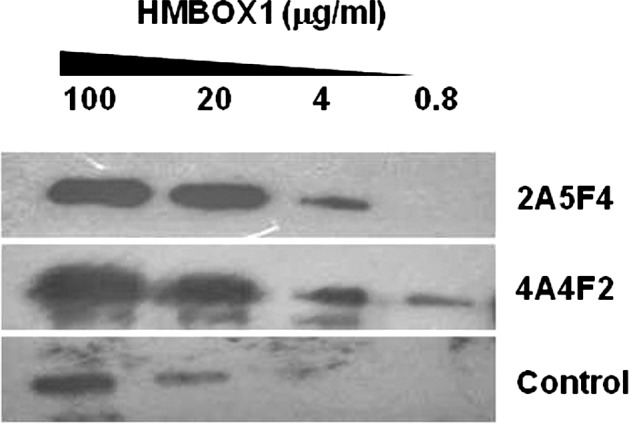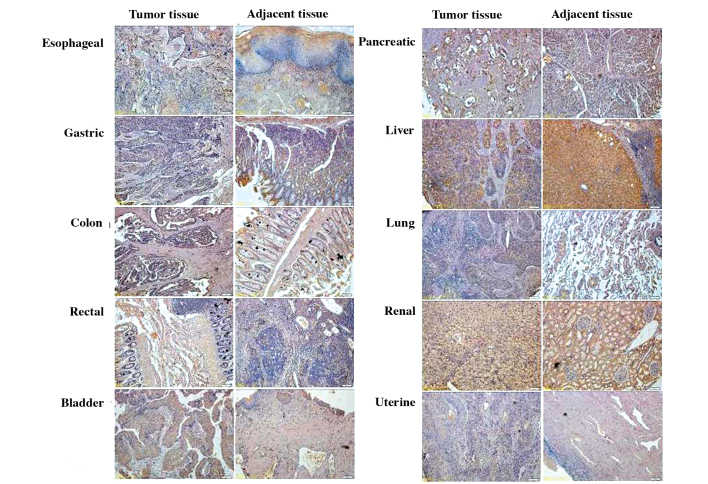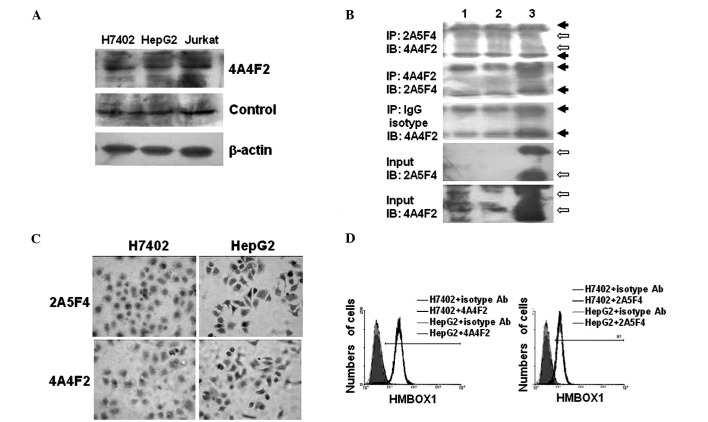Abstract
Homeobox containing 1 (HMBOX1) is a novel transcription factor. However, the expression of HMBOX1 and its functions in human cancer tissues and cell lines have not been fully defined. We generated two specific monoclonal antibodies, 2A5F4 and 4A4F2, against human HMBOX1. In the present study, these two anti-HMBOX1 antibodies were used to investigate the protein expression profile of HMBOX1 in various human cancer tissues and cell lines. The results showed that HMBOX1 in kidney tissue was mainly expressed in the renal tubule; the expression level of HMBOX1 was much higher in clear-cell carcinoma of the kidney originating from the renal tubule. Additionally, high levels of HMBOX1 protein were detected not only in pancreatic cancer tissue but also in the adjacent normal tissue. Notably, the expression level of HMBOX1 in liver cancer was dramatically decreased compared with that in the adjacent normal tissue. Abnormal expression of HMBOX1 in different types of carcinoma tissues suggests that HMBOX1 may be involved in the pathobiology of tumors.
Keywords: homeobox containing 1, monoclonal antibody, immunoanalytical methods, carcinoma
Introduction
Homeobox containing 1 (HMBOX1), a novel transcription factor, contains a homeobox domain in the N-terminus and an HNF1-N domain in the C-terminus. It is a member of the homeobox family of genes, which is characterized by the presence of a DNA sequence, the homeobox (1). Phylogenetic analyses have confirmed that HMBOX1 is more distantly related to HNF1A and HNF1B and has an atypical homeo-domain possessing a 21-amino acid insertion between the second and third helix (2,3). Zhang et al (3) previously cloned a splicing variant of HMBOX1, designated HMBOX1b, from a human pancreatic cDNA library. Compared to HMBOX1, HMBOX1b encodes a 304-amino acid protein that shares the N-terminal region but has no homeo-domain and C-terminal region.
HMBOX1 is highly conserved in humans, mice, rats, chickens and xenopus (2), and is detected in both the cytoplasm and nucleus of 10 normal human tissues, including the cerebrum, pancreas, kidney and liver (4). Co-transfection of HEK-293T cells with the pM-HMBOX1 plasmid and reporter plasmid pGAL45tkLUC indicates that the HMBOX1 protein may be a transcription repressor, while HMBOX1b only retains faint transcriptional repressive activity (2,3). We also found that HMBOX1 exhibits negative regulatory effects on natural killer cell activation (unpublished data).
In order to clarify the mechanisms of HMBOX1, we generated two specific mouse anti-human HMBOX1 monoclonal antibodies (mAbs), 2A5F4 and 4A4F2. The specificities of the mAbs were verified in HEK-293T cells, which were transformed by pcDNA3.1-HMBOX1 or siRNA/HMBOX1 (4). These two anti-HMBOX1 antibodies were used to investigate the protein expression profile of HMBOX1 in various human cancer tissues and cell lines by immunoanalytical methods, including immunoblotting, immunofluorescence and immunohistochemical assays. Abnormal expression of HMBOX1 was detected in the different types of carcinoma tissue.
Materials and methods
Cell lines and culture
The human hepatocarcinoma cell lines H7402 and HepG2 and the T-lymphocyte cell line Jurkat were cultured in RPMI-1640 medium (Gibco-BRL, Grand Island, NY, USA) supplemented with 10% calf serum (Sijiqing Co, Hangzhou, China) at 37°C in 5% CO2.
Antibodies against HMBOX1
Production of the mAbs against HMBOX1 was performed using a hybridoma technique. As previously described (4), the HMBOX1 fusion protein mixed with acid-treated naked Salmonella minnesota R595 bacteria was used to intraperitoneally immunize 8-week-old BALB/c female mice at 2-week intervals. When the titer of the mouse serum was higher than 1:105, cell fusion and cloning programs were performed. Two hybridoma lines, 2A5F4 and 4A4F2, were obtained, and both stably produced anti-HMBOX1 antibodies. Anti-HMBOX1 mAbs were prepared from the ascetic fluid of the BALB/c mice.
The anti-HMBOX1 antibody was purchased from Abcam Inc. (Cambridge, MA, USA; http://www.abcam.com/HMBOX1-antibody-ab50392.html). It is a rabbit anti-mouse polyclonal antibody that is used in Western blot analysis and ELISA assays. It was used as a positive control Ab in this study.
Western blot analyses
Cell extracts were separated by SDS-PAGE on a 12% polyacrylamide gel and then transferred onto PVDF membranes (Millipore, Billerica, MA, USA) by electroblotting. The membranes were blocked with 5% nonfat milk in TBS/0.1% Tween-20 and then incubated with mAb 2A5F4, mAb 4A4F2 or the control Ab against HMBOX1 for 2 h at room temperature (RT), and subsequently washed with TBST 3 times and incubated for 1 h with anti-murine antibody-conjugated horseradish peroxidase (HRP) (Dako, Glostrup, Denmark) or anti-rabbit antibody-conjugated HRP (Cell Signaling Technology, Danvers, MA, USA). After washing 5 times with TBST, the proteins were detected with the enhanced chemiluminescence system (Pierce Biotechnology, Rockford, IL, USA).
Immunoprecipitation
Cell extracts were prepared by resuspending 1×107 cells in ice-cold gentle lysis buffer [20 mM Tris-HCl (pH 7.5), 150 mM NaCl, 1 mM EGTA, 1 mM EDTA, 1 mM PMSF, 1 mM NaVO3, 50 mM NaF, 1% NP-40 and protease inhibitors] for 30 min on ice. The extracts were then clarified by centrifugation (16,000 x g for 15 min at 4°C), and the supernatant was collected. After incubation with protein A-Sepharose beads (GenScript, Nanjing, China) for 10 min at 4°C, the supernatant was cleared and concentrated using the Bradford method while BSA (Bio-Rad Laboratories, Hercules, CA, USA) was used as a standard. The cleared extract was incubated at 4°C overnight with mAb 2A5F2 or mAb 4A4F2 at a dose of 5 μg/500 μg total protein in 500 μl and then incubated with 50 μl protein A-Sepharose beads at 4°C for 1 h. The immune complexes were recovered by centrifugation, washed 3 times with PBS buffer, and solubilized in loading buffer by heating at 100°C for 5 min. Immunoprecipitated complexes were electrophoresed on a 12% reduced SDS polyacrylamide gel, transferred to a PVDF membrane, and immunoblotted as previously described (5).
Immunostaining and flow cytometry
The hepatic cell lines were adjusted to 1×106 cells/ml, fixed in 4% cold paraformaldehyde for 10 min at RT, and permeabilized with vigorous overtaxing in 500 μl ice-cold 0.1% saponin per 106 cells. The primary antibody against HMBOX1 (mAb 2A5F4 or mAb 4A4F2) was then added at a dilution of 1:50, and the cells were incubated at 4°C overnight. After washing three times with PBS, cells were resuspended in 100 μl PBS and incubated for 1 h with FITC-conjugated anti-mouse IgG antibody at a dilution of 1:100 (eBioscience, San Diego, CA, USA). Fluorescence was assayed using a flow cytometer (BD Biosciences, Franklin Lakes, NJ, USA). The isotype-matched control sample was included as the standard control.
Immunohistochemistry
The immunohistochemical SP staining method was used to detect the HMBOX1 protein levels in hepatocytes growing on glass chips or a tissue microarray (OD-CT-Com03-002; Shanghai Biochip, China). The sections were incubated at 4°C overnight with mAb 2A5F4 or mAb 4A4F2 in a humidified chamber. The mouse SP detection and DAB envision systems (both from Zimbio, Beijing, China) were applied.
Results
Use of 2A5F4 mAb and 4A4F2 mAb in Western blot analysis
To verify the specificity and sensitivity of mAb 2A5F4 and mAb 4A4F2 against HMBOX1, the HMBOX1 fusion protein was gradient diluted and detected by Western blot analysis with mAb 2A4F4 and mAb 4A4F2. As shown in Fig. 1, the lowest concentration of the HMBOX1 protein detected was 0.8 μg/ml. Thus, the specificity and sensitivity of mAb 2A5F4 and mAb 4A4F2 were found to be comparable with that of the commercial HMBOX1 antibody from Abcam Inc.
Figure 1.

Specificity and sensitivity of mAb 4A4F2 and mAb 2A5F2 against HMBOX1. Fused HMBOX1 proteins of different concentrations were measured using mAb 4A4F2, mAb 2A5F2 or the control Ab.
Abnormal expression of HMBOX1 in carcinoma tissues
Previous research has confirmed that HMBOX1 is widely expressed in human tissues (4). Here, the expression profile of HMBOX1 was further identified in various human tumors. As shown in Fig. 2, a tissue microarray was used to analyze the expression of HMBOX1. The expression level of HMBOX1 was found to be dramatically decreased in liver cancer compared with that in adjacent normal tissue, whereas HMBOX1 in kidney tissue was mainly expressed in the renal tubule, and the expression level of HMBOX1 was much higher in clear-cell carcinoma of the kidney originating from the renal tubule. Additionally, there was no significant change in HMBOX1 expression in the other cancer tissues tested. Similar to the results reported by Chen et al (2), high levels of HMBOX1 protein were detected not only in pancreatic cancer but also in adjacent normal tissue.
Figure 2.
Expression of HMBOX1 in human cancer tissues. Tissue microarrays containing 20 tissue samples of 10 types of carcinomas and adjacent normal tissues were obtained for staining with mAb 4A4F2. Original magnification, x400.
Expression of HMBOX1 in the hepatocellular cell lines H7402 and HepG2
Cell lines are commonly used as in vitro models in scientific research. Thus, the expression of HMBOX1 was further evaluated in the human hepatocellular carcinoma cell lines H7402 and HepG2 by immunoanalytical methods. First, the HMBOX1 protein was found to be localized in the nucleus and cytoplasm as detected by Western blot and immunohistochemical analyses (Fig. 3A and C). Jurkat, a T-lymphocyte cell line, was used as a positive control. Similar to the control Ab, positive immunostaining for HMBOX1 was observed in both the H7402 and HepG2 cells using mAb 4A4F2 (Fig. 3A), which is consistent with previous reports (4). Second, immunoprecipitation was performed with mAb 2A5F4 and mAb 4A4F2. As shown in Fig. 3B, mAb 2A5F4 was found to immunoprecipitate two different variants of HMBOX1, HMBOX1 (410aa, 47 kDa) and HMBOX1b (304aa, 35 kDa), from the H7402 and HepG2 cells, while mAb 4A4F2 did not. One possible explanation was that the type of mAb 4A4F2 used was IgM (4), which has poor affinity to protein A-Sepharose beads (6), and thus the immune complex could not be precipitated. Finally, mAb 2A5F4 and mAb 4A4F2 were also used for immunohisto chemical (Fig. 3C) and flow cytometric (Fig. 3D) analyses, and as expected no significant difference in expression was noted between the cell lines. These findings demonstrated that the HMBOX1 protein was expressed in H7402 and HepG2 cells, and that these cell lines are suitable for investigating the mechanisms of HMBOX1 in HCC development in vitro.
Figure 3.
Expression of HMBOX1 in the hepatocellular cell lines H7402 and HepG2. (A) Western blot analysis was performed using mAb 4A4F2 or the control Ab. Jurkat cells were used as positive control cells, and the β-actin messenger was used as the internal control. (B) Immunoprecipitation analysis. Cell lysates from hepatocellular cell lines (lane 1, H7402; lane 2, HepG2) and fused HMBOX1 proteins (lane 3) were pulled down by mAb 2A5F4, mAb 4A4F2 or the Ig isotype antibody, respectively. Complexes and input (non-immunoprecipitated whole cell extract) were detected by Western blot analysis using mAb 4A4F2 or mAb 2A5F4 as described in Materials and methods. ➙, IgH chain or IgL chain; ⇨, HMBOX1. (C) Immunohistochemical method. Hepatocytes (H7402 and HepG2) growing on glass chips were immunostained using mAb 4A4F2 or mAb 2A5F4 as primary antibody, and the mouse SP detection system and the DAB envision system were applied. Original magnification, x400. (D) Flow cytometric assay. The hepatocellular cell lines H7402 and HepG2 were labeled with mAb 2A5F4 or mAb 4A4F2, and FITC-labeled secondary antibody was applied before FACS analysis. Isotype antibodies were used as the control.
Discussion
In the present study, the protein expression profile of HMBOX1 was analyzed in different types of human cancer tissues and cell lines. Abnormal expression of HMBOX1 was noted in several carcinomas, particularly in liver and renal cancer. It was previously suggested that HMBOX1 may be correlated with tumorigenesis. Armendariz and Krauss (7) and Van Wering et al (8) reported that hepatoma differentiation and the suppression of hepato-specific gene expression are usually accompanied by a decrease in the expression of HNF1α, a member of the homeobox genes. Therefore, HMBOX1 may potentially be an important negative regulator of tumor pathobiology.
Homeobox family genes are capable of interacting with multiple coactivators, leading to a strong enhancement of transcription. For example, HNF1α can physically interact with PCBD1, HATs, CBP, RAC3, GATA5, Neurog3 and Cdx2 (8–12). Thus, further functional research of HMBOX1 may be of value. As mAb 2A5F4 and mAb 4A4F2 can be used for immunoprecipitation and immunofluorescence, potential coactivators of HMBOX1 may also be identified with antibodies against HMBOX1.
In the present study, high expression levels of HMBOX1 were detected in hepatic tissue, the renal tubule and pancreatic tissue. These tissues are closely related with glycometabolism, and previous studies have demonstrated that heterozygous mutations in genes coding for HNF1 homeobox A (HNF1A), hepatocyte nuclear factor-4 A (HNF4A), and HNF1 homeobox B (HNF1B) can cause maturity-onset diabetes of the young (MODY). MODY is characterized by progressive β-cell failure and inability to increase insulin secretion in response to hyperglycemia (13). Thus, HMBOX1 may play a role in the process of glycometabolism, and may be related to MODY. To conclude, the mechanism of HMBOX1 has yet to be elucidated and may pose a challenge for future research.
Acknowledgments
This study was supported by grants from the National Natural Science Foundation of China (30901307, 30972962) and the Ministry of Science and Technology of China (2007AA021000, 2007AA021109, 2006CB504303 and 2008ZX10002-008).
References
- 1.Lawrence PA, Morata G. Homeobox genes: their function in Drosophila segmentation and pattern formation. Cell Mol Immunol. 1994;78:181–189. doi: 10.1016/0092-8674(94)90289-5. [DOI] [PubMed] [Google Scholar]
- 2.Chen S, Saiyin H, Zeng X, et al. Isolation and functional analysis of human HMBOX1, a homeobox containing protein with transcriptional repressor activity. Cytogenet Genome Res. 2006;114:131–136. doi: 10.1159/000093328. [DOI] [PubMed] [Google Scholar]
- 3.Zhang M, Chen S, Li Q, Ling Y, Zhang J, Yu L. Characterization of a novel human HMBOX1 splicing variant lacking the homeodomain and with attenuated transcription repressor activity. Mol Biol Rep. 2010;37:2767–2772. doi: 10.1007/s11033-009-9815-9. [DOI] [PubMed] [Google Scholar]
- 4.Dai J, Wu L, Zhang C, Zheng X, Tian Z, Zhang J. Recombinant expression of a novel human transcriptional repressor HMBOX1 and preparation of anti-HMBOX1 monoclonal antibody. Cell Mol Immunol. 2009;6:261–268. doi: 10.1038/cmi.2009.35. [DOI] [PMC free article] [PubMed] [Google Scholar]
- 5.Tsangaridou E, Polioudaki H, Sfakianaki R, et al. Differential detection of nuclear envelope autoantibodies in primary biliary cirrhosis using routine and alternative methods. BMC Gastroenterol. 2010;10:28. doi: 10.1186/1471-230X-10-28. [DOI] [PMC free article] [PubMed] [Google Scholar]
- 6.Balint JP, Jr, Ikeda Y, Nagai T, Terman DS. Isolation of human and canine IgM utilizing protein A affinity chromatography. Immunol Commun. 1981;10:533–540. doi: 10.3109/08820138109055703. [DOI] [PubMed] [Google Scholar]
- 7.Armendariz AD, Krauss RM. Hepatic nuclear factor 1-alpha: inflammation, genetics, and atherosclerosis. Curr Opin Lipidol. 2009;20:106–111. doi: 10.1097/mol.0b013e3283295ee9. [DOI] [PubMed] [Google Scholar]
- 8.Van Wering HM, Huibregtse IL, van der Zwan SM, et al. Physical interaction between GATA-5 and hepatocyte nuclear factor-1alpha results in synergistic activation of the human lactasephlorizin hydrolase promoter. J Biol Chem. 2002;277:27659–27667. doi: 10.1074/jbc.M203645200. [DOI] [PubMed] [Google Scholar]
- 9.Sourdive DJ, Transy C, Garbay S, Yaniv M. The bifunctional DCOH protein binds to HNF1 independently of its 4-alpha-carbinolamine dehydratase activity. Nucleic Acids Res. 1997;25:1476–1484. doi: 10.1093/nar/25.8.1476. [DOI] [PMC free article] [PubMed] [Google Scholar]
- 10.Soutoglou E, Papafotiou G, Katrakili N, Talianidis I. Transcriptional activation by hepatocyte nuclear factor-1 requires synergism between multiple coactivator proteins. J Biol Chem. 2000;275:12515–12520. doi: 10.1074/jbc.275.17.12515. [DOI] [PubMed] [Google Scholar]
- 11.Dohda T, Kaneoka H, Inayoshi Y, Kamihira M, Miyake K, Iijima S. Transcriptional coactivators CBP and p300 cooperatively enhance HNF-1alpa-mediated expression of the albumin gene in hepatocytes. J Biochem. 2004;136:313–319. doi: 10.1093/jb/mvh123. [DOI] [PubMed] [Google Scholar]
- 12.Smith SB, Gasa R, Watada H, Wang J, Grimen SC, German MS. Neurogenin3 and hepatic nuclear factor 1 cooperate in activating pancreatic expression of Pax4. J Biol Chem. 2003;278:28254–28259. doi: 10.1074/jbc.M302229200. [DOI] [PubMed] [Google Scholar]
- 13.Owen K, Hattersley AT. Maturity-onset diabetes of the young: from clinical description to molecular genetic characterization. Best Pract Res Clin Endocrinol Metab. 2001;15:309–323. doi: 10.1053/beem.2001.0148. [DOI] [PubMed] [Google Scholar]




